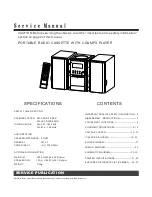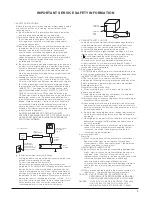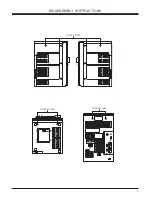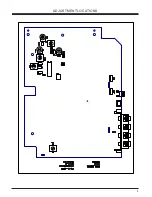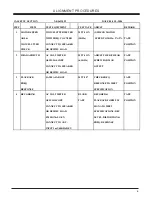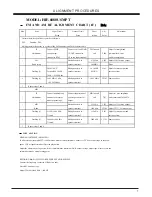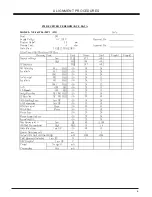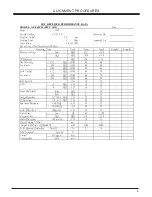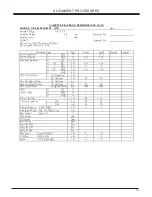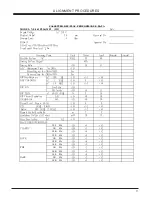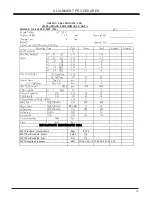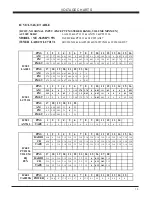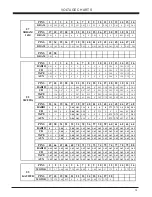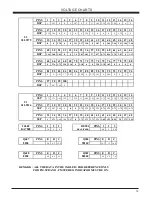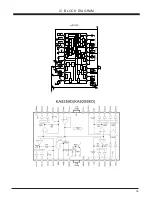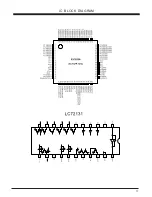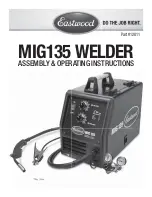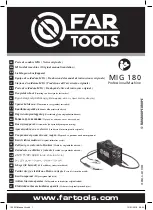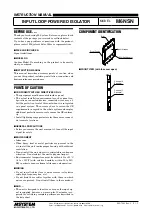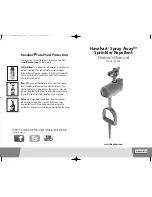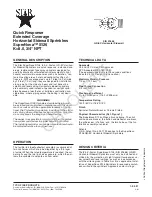
2
IMPORTANT SERVICE SAFETY INFORMATION
ANTENNA
TERMINAL
OHMMETER
OM
EXPOSED
METAL
PART
TEST ALL
EXPOSED METAL
SURFACES
(READING SHOULD
NOT BE ABOVE
0.5mA)
LEAKAGE
CURRENT
TESTER
EARTH
GROUND
DEVICE
UNDER
TEST
2-WIRE CORD
ALSO TEST WITH
PLUG REVERSED
(USING AC ADAPTER
PLUG AS REQUIRED)
AC LEAKAGE TEST
2. PRODUCT SAFETY NOTICE
some electrical and mechanical parts have special safety
related characteristics which are often not evident from
visual inspection. Nor can the protection they give
necessarily be obtained by replacing them with
components rated for higher voltage , wattage, etc. Parts
that have special safety characteristics are identified by
a
on schematic and parts list. Use of a substitute
replacement that dose not have the same safety
characteristics as the recommended replacement part
might create shock, fire, and/or other hazards. Product
safety is under review continuously and new instructions are
issued whenever Appropriate.
3. Servicing precautions
CAUTION: before servicing the unit covered by this service
by this service manual and its supplements. Read and follow
the SAFETY PRECAUTIONS on this page.
NOTE: if unforeseen circumstances create a conflict
between the following servicing precautions and any of the
Safety precautions, always follow the safety precautions.
Remember: safety first.
General servicing precautions.
a. Always unplug the unit s AC power cord from the AC
power source Before:
(1)removing or reinstalling any component, circuit board,
module or any other unit assembly.
(2)disconnecting or reconnecting any unit electrical plug or
other Electrical connection.
(3)connecting a test substitute in parallel with an electrical
capacitor caution: a wrong part substitution or incorrect
polarity installation Of electrolytic capacitors may result in
an explosion hazard
b. Do not defeat any plug/socket b+ voltage interlocks with
which the unit covered by this service manual might be
equipped.
c. Do not apply AC power to this unit and/or any its electrical
assemblies unless all solid-state device heat sinks are
correctly installed.
d. Always connect a test unit instrument s ground lead to
the unit s chassis ground before connecting the test
instrument s positive lead always remove the test
instrument s ground lead last.
CAUTION: USE OF CONTROLS, ADJUSTMENTS OR
PERFORMANCE OF PROCEDURES HEREIN MAY
RESULT IN HAZARDOUS RADIATION
EXPOSURE.
DANGER:
IF INTERLOCK FAILS OR IS DEFEATED, THE LASER
LIGHT IS ABLE TO FUNCTION. THE LASER IS
INVISIBLE, AVOID DIRECT EXPOSURE TO BEAM.
4. Laser precautions
Warning!
(1)When servicing.(In case it is necessary to confirm laser
Beam emission ) be sure not to place your eyes any
closer than 1or 30cm from thesurface of the objective
lens on the optical pickup block.
HANDLING THE LASER PICKUP
( 2)Laser Diodes are Extremely Susceptible to damage from
static electricity even if a static discharge dies not ruin
the diode, it can
shorten its life or cause it to work
improperly. When replacing the pickup, use a conductive
mat on the floor and desk and wear a wrist band
connected to ground through a 1Mohm resistor
to protect the laserdiode from static damage. If the lens
should get dusty, blow off thedust carefully fromthe
object.
(3)There are no adjustable parts in the pickup assembly. If it
is defective,
replace the whole pickup assembly.
1. SAFETY PRECAUTIONS
Before returning a unit to the customer, always make a safety
check of the entire unit, including, but not limited to the
following items:
a. Be sure that no built-in protective devices are defective
and/or have been defeated during servicing.
(1)protective shields are provided to protect both the
technician and the customer. Correctly replace all
missing protective shields including any removed for
servicing convenience.
(2)when reinstalling the chassis and/or other assemblies in
the cabinet, be sure to put back in place all protective
devices, including , but not limited to , nonmetallic
control knobs, insulating fishpapers. adjustment and
compartment covers/shields and isolating resistor/
capacitor networks. Do not operate this or permit it to be
operated Without all protective devices correctly
installed and functioning .
b. Be sure that there are no cabinet openings through which
an adult or child might be able to insert their fingers and
contact a hazardous voltage. Such openings include, but
are not limited to, excessively wide cabinet ventilation
slots, and an improperly fitted and/or incorrectly secured
cabinet back cover.
c. Leakage current hot check - with the unit completely
reassembled ,plug the AC line cord directly into a 120V
AC outlet. (Do not use an isolation transformer during this
test.) Use a leakage current tester or a metering system
that complies with American National standards Institute
(ANSI) C101.1 Leakage Current for Appliances and
Underwriters Laboratories(UL) 1410 (50.7). WITH THE
UNIT AC switch first in the ON position And then in the
OFF position, measure from a known earth ground (metal
water pipe, conduit, etc.) To all exposed metal parts of
the Unit (antennas, handle bracket, metal cabinet, screw
heads , metallic overlays, control shaft, etc.) Especially
any exposed metal parts that offer an electrical return
path to the chassis. Any current measured must not
exceed 0.5 milliamp, reverse the unit power cord plug in
the outlet and repeat test .
ANY MEASUREMENTS NOT WITHIN THE LIMITS
SPECIFIED HERENING INDICATE A POTENTIAL SHOCK
HAZARD THAT MUST BE ELIMINATED
RETURNING THE
UNIT TO THE CUSTOMER.
d. Insulation resistance test cold check:
unplug the power supply cord and connect a jumper wire
between the two prongs of the plug .
Turn on the power switch of the unit.
Measure the resistance with an ohmmeter between
jumpered AC PLUG AND EACH Exposed metallic cabinet
part on the unit, such as screw heads, antenna, control
shafts, handle brackets, etc. When the exposed metallic
part has a return path to the chassis , the reading should
be between 1 and 5.2 megohms. When there is no return
path to the chassis, the reading must be
infinite
If it is
not within the limits specified, there is the possibility of a
shock hazard, and the unit must be repaired and
rechecked before it is returned to the customer.
Summary of Contents for HIF-6880USMPT
Page 1: ...HIF 6880USMPT...
Page 4: ...DISASSEMBLY INSTRUCTIONS MODEL NE 562 3 SCREW3X10PA SCREW3X10PA SCREW3X10PA...
Page 5: ...ADJUSTMENT LOCATIONS 4...
Page 17: ...16 IC BLOCK DIAGRAM MODEL NE 562...
Page 18: ...17 IC BLOCK DIAGRAM MODEL NE 562...
Page 19: ...18 IC BLOCK DIAGRAM MODEL NE 562...
Page 20: ...19 IC BLOCK DIAGRAM MODEL NE 562...
Page 21: ...20 IC BLOCK DIAGRAM MODEL NE 562...
Page 22: ...BLOCK DIAGRAM 21...
Page 23: ...WIRING DIAGRAM 22...
Page 24: ...SCHEMATIC DIAGRAMS 22 23...
Page 25: ...SCHEMATIC DIAGRAMS 23 24...
Page 26: ...SCHEMATIC DIAGRAMS 24 25...
Page 27: ...SCHEMATIC DIAGRAMS 25 26...
Page 28: ...SCHEMATIC DIAGRAMS 26 27...
Page 29: ...SCHEMATIC DIAGRAMS 27 28...
Page 30: ...SCHEMATIC DIAGRAMS 28 29...
Page 31: ...SCHEMATIC DIAGRAMS 28 30...
Page 32: ...PRINTED CIRCUIT BOARDS 31 173 056320 01 173 056301 09...
Page 33: ...PRINTED CIRCUIT BOARDS 32 173 056320 01...
Page 34: ...PRINTED CIRCUIT BOARDS 33...
Page 35: ...PRINTED CIRCUIT BOARDS 34 173 056351 01 173 056356 01 173 0563 1 09...
Page 36: ...35 EXPLODED VIEW PARTS LIST CABINET MODEL NE 562...


